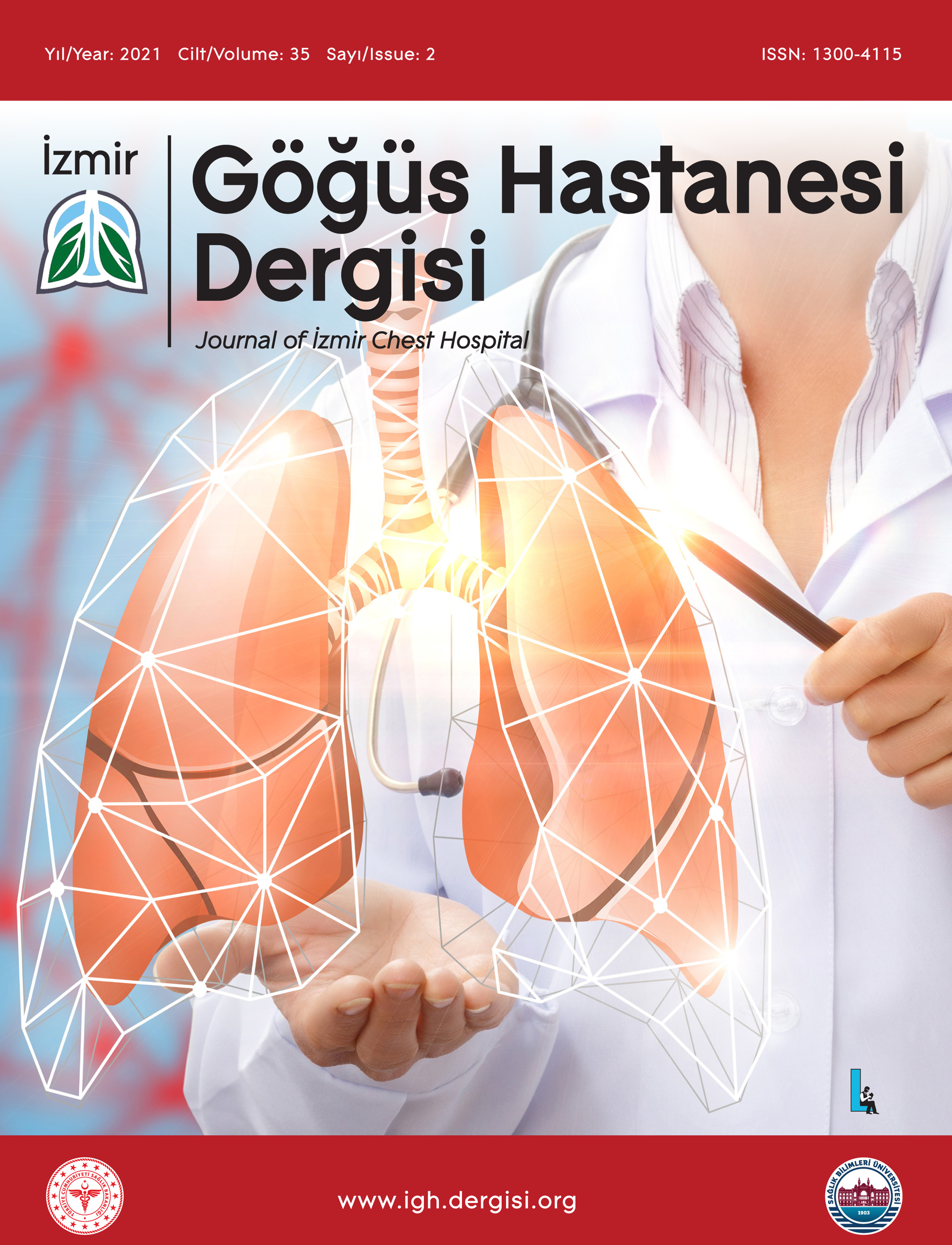Küçük Hücreli Dışı Akciğer Kanseri Olgularının Yoğun Bakım Mortalitesini Öngörmede APACHE II ve MPM II-0 Skorlarının Rolleri: 8 Yıllık Deneyimimiz
Burcu Tunay, Cem Erdoğanİstanbul Medipol Üniversitesi Tıp Fakültesi, Anesteziyoloji ve Reanimasyon Anabilim Dalı, İstanbul, TürkiyeAmaç: Küçük hücreli dışı akciğer kanseri (KHDAK) tüm akciğer kanseri olgularının yaklaşık %85ini oluşturmaktadır. Bu çalışmada, KHDAKlı hastaların yoğun bakım ünitesi (YBÜ) mortalite riskini öngörmede, Akut Fizyoloji ve Kronik Sağlık Değerlendirmesi II (APACHE II) ve Mortalite Tahmin Modeli II-0 (MPM II-0) skorlama sistemlerinin, tümörle ilgili klinik ve demografik bazı özelliklerin tahmin güçlerinin araştırılması amaçlandı.
Gereç ve Yöntemler: Retrospektif olan bu çalışmaya YBÜye kabul edilmiş 186 KH-DAKlı hasta dahil edildi. Hastaların klinik ve demografik özellikleri, skorlama puanları, tümör özellikleri ve YBÜ sonlanımları hastanemiz veri tabanından elde edildi.
Bulgular: Çalışmaya 135 erkek ve 51 kadın hasta dahil edildi. Hastaların yaş ortalaması 66,47±12,03 yıldı. Taburcu olan ve eksitusla sonlanan gruplarda yaş (p=0,237) ve cinsiyet (p=0,768) açısından anlamlı farklılık yoktu. MPM II-0ın kesim noktası >58 alındığı zaman, duyarlılığı %75,9, seçiciliği %84,6 olarak bulundu. Çoklu regresyon analizinde rekürrens/progresyonun (p<0,001), APACHE II skoru >20nin (p=0,010) ve MPM II skoru >58in (p<0,001) bağımsız mortalite öngörücüleri oldukları, operasyon sonrası YBÜye alınmanın (p=0,001) ise tek bağımsız sağkalım öngörücüsü olduğu görüldü.
Sonuç: KHDAKlı hastalarının YBÜ mortalite tahmini yapılırken APACHE II ve MPM II-0 skorlarının değerlendirilmesini ve tümör rekürrens/progresyonunun dikkate alınmasını öneririz. Bununla beraber, KHDAKlı hastaların YBÜ mortalitesinde etkili faktörlerin belirlenmesi amacıyla; çok merkezli, prospektif ve daha fazla olası parametrenin dahil edildiği geniş kapsamlı çalışmalara ihtiyaç vardır.
The Role of APACHE II and MPM II-0 Scores in Predicting Intensive Care Mortality in Non-Small Cell Lung Cancer Cases: 8 Years of Experience
Burcu Tunay, Cem ErdoğanDepartment of Anesthesiology and Reanimation, Istanbul Medipol University Faculty of Medicine, İstanbul, TürkiyeObjective: Non-small cell lung cancer (NSCLC) accounts for approximately 85% of all lung cancer cases. In this study, we aimed to investigate the strength of Acute Physiology and Chronic Health Evaluation-II (APACHE II) and Mortality Probability Model II-0 (MPM II-0) scoring systems and some tumor-related and clinicodemographic factors to predict the intensive care unit (ICU) mortality risk of patients with NSCLC.
Material and Methods: This retrospective study included 186 NSCLC patients admitted to the ICU. Clinicodemographic characteristics, scoring scores, tumor characteristics, and ICU outcomes of the patients were obtained from our hospital database.
Results: One hundred and thirty-five male and 51 female patients were included in the study and the mean age of the patients was 66.47±12.03 years. There was no significant difference in age (p=0.237) and gender (p=0.768) between discharged and exitus groups. When the cutoff point of MPM II-0 was taken as >58, the sensitivity was found to be 75.9% and the selectivity as 84.6%. In multiple regression analysis, recurrence/progression (p<0.001), APACHE II score >20 (p=0.010), and MPM II-0 score >58 (p<0.001) were found to be independent predictors of mortality, and post-operative admission to the ICU (p=0.001) was found to be only independent predictor of survival.
Conclusion: We recommend that APACHE II and MPM II-0 scores should be evaluated and tumor recurrence/progression should be taken into account when estimating ICU mortality in patients with NSCLC. However, to reveal the effective factors in ICU mortality of patients with NSCLC, there is a need for multicenter, prospective, and large-scale studies examining more possible parameters.
Makale Dili: Türkçe






